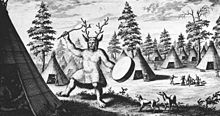ਸ਼ਮਨਵਾਦ
ਸ਼ਮਨਵਾਦ ਜਾਂ ਸ਼ਾਮਨਵਾਦ ਇੱਕ ਅਕੀਦਾ ਹੈ ਜਿਸ ਵਿੱਚ ਇੱਕ ਅਭਿਆਸੀ ਹੁੰਦਾ ਹੈ ਜੋ ਚੇਤਨਾ ਦੀਆਂ ਬਦਲੀਆਂ ਅਵਸਥਾਵਾਂ ਵਿੱਚ ਪਹੁੰਚ ਸਕਦਾ ਹੈ ਤਾਂ ਜੋ ਉਹ ਆਤਮਕ ਆਪਣੇ ਅਕੀਦੇ ਅਨੁਸਾਰ ਰੂਹਾਂ ਦੇ ਸੰਸਾਰ ਨੂੰ ਦੇਖ ਸਕਣ ਅਤੇ ਉਨ੍ਹਾਂ ਨਾਲ ਗੱਲਬਾਤ ਕਰਨ ਦੇ ਯੋਗ ਹੁੰਦਾ ਹੈ ਅਤੇ ਇਨ੍ਹਾਂ ਪਾਰਦਰਸ਼ੀ ਊਰਜਾਵਾਂ ਨੂੰ ਕਬਜ਼ੇ ਵਿੱਚ ਕਰ ਕੇ ਇਸ ਸੰਸਾਰ ਵਿੱਚ ਕੰਮ ਲੈਂਦਾ ਹੈ।[1]
ਅਕੀਦਿਆਂ ਅਤੇ ਅਭਿਆਸਾਂ ਜਿਨ੍ਹਾਂ ਨੂੰ "ਸ਼ਮਨਿਕ" ਸ਼੍ਰੇਣੀਬੱਧ ਕੀਤਾ ਗਿਆ ਹੈ, ਨੇ ਬਹੁਤ ਵਿਭਿੰਨ ਵਿਸ਼ਿਆਂ ਦੇ ਵਿਦਵਾਨਾਂ ਨੂੰ ਖਿੱਚਿਆ ਹੈ, ਜਿਨ੍ਹਾਂ ਵਿੱਚ ਮਾਨਵ-ਵਿਗਿਆਨੀ, ਪੁਰਾਤੱਤਵ-ਵਿਗਿਆਨੀ, ਇਤਿਹਾਸਕਾਰ, ਧਾਰਮਿਕ-ਅਧਿਐਨ ਵਿਦਵਾਨ, ਦਾਰਸ਼ਨਿਕ ਅਤੇ ਮਨੋਵਿਗਿਆਨੀ ਸ਼ਾਮਲ ਹਨ। ਇਸ ਵਿਸ਼ੇ 'ਤੇ ਸੈਂਕੜੇ ਕਿਤਾਬਾਂ ਅਤੇ ਅਕਾਦਮਿਕ ਪੇਪਰ ਤਿਆਰ ਕੀਤੇ ਗਏ ਹਨ, ਇੱਕ ਹਾਣੀ-ਰੀਵਿਊ-ਸ਼ੁਦਾ ਅਕਾਦਮਿਕ ਰਸਾਲਾ ਸ਼ਮਨਵਾਦ ਦੇ ਅਧਿਐਨ ਲਈ ਸਮਰਪਿਤ ਹੈ। ਵੀਹਵੀਂ ਸਦੀ ਵਿਚ, ਟੱਕਰਾਵੇਂ-ਸਭਿਆਚਾਰਕ ਅੰਦੋਲਨਾਂ ਵਿੱਚ ਸ਼ਾਮਲ ਬਹੁਤ ਸਾਰੇ ਪੱਛਮੀ ਲੋਕਾਂ ਨੇ ਆਧੁਨਿਕ ਜਾਦੂ-ਧਾਰਮਿਕ ਅਭਿਆਸਾਂ ਦੀ ਸਿਰਜਣਾ ਕੀਤੀ ਹੈ ਅਤੇ ਉਨ੍ਹਾਂ ਨੇ ਸੰਸਾਰ ਭਰ ਤੋਂ ਮੂਲਵਾਸੀ ਧਰਮਾਂ ਦੇ ਲੋਕਾਂ ਦੇ ਵਿਚਾਰਾਂ ਤੋਂ ਪ੍ਰਭਾਵਤ ਹੋ ਕੇ ਅਜਿਹੀ ਸਥਿਤੀ ਪੈਦਾ ਕੀਤੀ ਹੈ ਜਿਸ ਨੂੰ ਨਵ-ਸ਼ਮਨਵਾਦ ਜਾਂ ਨਵ-ਸ਼ਮਨਵਾਦੀ ਲਹਿਰ ਕਿਹਾ ਜਾਂਦਾ ਹੈ।[2] ਇਸਨੇ ਬਹੁਤ ਸਾਰੀਆਂ ਨਵ-ਪੈਗਨ ਅਭਿਆਸਾਂ ਦੇ ਵਿਕਾਸ ਨੂੰ ਪ੍ਰਭਾਵਤ ਕੀਤਾ ਹੈ, ਅਤੇ ਨਾਲ ਹੀ ਸਭਿਆਚਾਰਕ ਨਿਰਧਾਰਨ, ਸ਼ੋਸ਼ਣ ਅਤੇ ਗ਼ਲਤ ਜਾਣਕਾਰੀ ਦੇਣ ਦੇ ਦੋਸ਼ਾਂ ਦਾ ਸਾਹਮਣਾ ਕਰਨਾ ਪਿਆ ਹੈ,[3] ਜਦੋਂ ਬਾਹਰਲੇ ਨਿਰੀਖਕਾਂ ਨੇ ਉਨ੍ਹਾਂ ਸਭਿਆਚਾਰਾਂ ਦੀ ਪ੍ਰਤੀਨਿਧਤਾ ਕਰਨ ਦੀ ਕੋਸ਼ਿਸ਼ ਕੀਤੀ ਹੈ ਜਿਸ ਨਾਲ ਉਹ ਸਬੰਧਤ ਨਹੀਂ ਹਨ।[4][5]
ਸ਼ਬਦਾਵਲੀ
[ਸੋਧੋ]ਨਿਰੁਕਤੀ
[ਸੋਧੋ]
ਸ਼ਬਦ ਸ਼ਮਨਵਾਦ ਦਾ ਮੂਲ ਸ਼ਾਇਦ ਮਾਂਚੂ-ਤੁੰਗੁਸੀ ਭਾਸ਼ਾਵਾਂ ਦੇ ਸ਼ਬਦ ਸ਼ਮਨ, ਮਤਲਬ, "ਜਿਹੜਾ ਜਾਣਦਾ ਹੈ" ਤੋਂ ਹੈ।[7] ਸ਼ਬਦ ਸ਼ਮਨ ਏਵੇਂਕੀ ਸ਼ਬਦ ਸ਼ਮਾਨ, ਤੋਂ ਵੀ ਉਪਜਿਆ ਹੋ ਸਕਦਾ ਹੈ।[8] ਤੁੰਗੁਜ਼ਿਕ ਸ਼ਬਦ ਨੂੰ ਬਾਅਦ ਵਿੱਚ ਰੂਸ ਨੇ ਸਾਈਬੇਰੀਆ ਵਿੱਚ ਮੂਲ ਲੋਕਾਂ ਨਾਲ ਗੱਲਬਾਤ ਕਰਦਿਆਂ ਅਪਣਾਇਆ ਗਿਆ। ਇਹ ਜਲਾਵਤਨ ਰੂਸੀ ਚਰਚਮੈਨ ਅਵਵਾਕੁਮ ਦੀਆਂ ਯਾਦਾਂ ਵਿੱਚ ਪਾਇਆ ਮਿਲਦਾ ਹੈ।[9]
ਇਸ ਸ਼ਬਦ ਨੂੰ ਡੱਚ ਯਾਤਰੀ, ਨਿਕੋਲਸ ਵਿਟਸੇਨ ਅਖ਼ੀਰ 17 ਵੀਂ ਸਦੀ ਵਿੱਚ ਪੱਛਮੀ ਯੂਰਪ ਲਿਆਇਆ ਸੀ, ਜਿਸ ਨੇ ਤੁੰਗੁਜ਼ਿਕ - ਅਤੇ Samoyedic - ਬੋਲਣ ਵਾਲੇ ਸਾਇਬੇਰੀਆ ਦੇ ਆਦਿਵਾਸੀ ਲੋਕਾਂ ਦਾ ਜ਼ਿਕਰ ਆਪਣੀ ਕਿਤਾਬ Noord en Oost Tataryen (1692) ਵਿੱਚ ਕੀਤਾ ਹੈ।[10] ਐਡਮ ਬ੍ਰਾਂਡ, ਲਬੇਕ ਦਾ ਇੱਕ ਵਪਾਰੀ ਸੀ, ਜਿਸਨੇ 1698 ਵਿੱਚ ਚੀਨ ਵਿੱਚ ਇੱਕ ਰੂਸੀ ਦੂਤਘਰ ਬਾਰੇ ਆਪਣਾ ਬਿਰਤਾਂਤ ਪ੍ਰਕਾਸ਼ਿਤ ਕੀਤਾ ਸੀ; ਉਸੇ ਸਾਲ ਪ੍ਰਕਾਸ਼ਤ ਹੋਈ ਉਸ ਦੀ ਪੁਸਤਕ ਦੇ ਅਨੁਵਾਦ ਨੇ ਅੰਗਰੇਜ਼ੀ ਬੋਲਣ ਵਾਲਿਆਂ ਦੀ ਸ਼ਮਨ ਸ਼ਬਦ ਨਾਲ ਵਾਕਫੀਅਤ ਕਰਵਾਈ ਸੀ।[11]
ਹਵਾਲੇ
[ਸੋਧੋ]- ↑ Singh, Manvir (2017). "The cultural evolution of shamanism". Behavioral and Brain Sciences. 41: e66: 1–61. doi:10.1017/S0140525X17001893. PMID 28679454.
- ↑ Gredig, Florian (2009). Finding New Cosmologies. Berlin: Lit Verlag Dr. W. Hopf.
- ↑ Kehoe, Alice Beck (2000). Shamans and religion: an anthropological exploration in critical thinking. Prospect Heights, Ill.: Waveland Press. ISBN 978-1-57766-162-7.
- ↑ Wernitznig, Dagmar, Europe's Indians, Indians in Europe: European Perceptions and Appropriations of Native American Cultures from Pocahontas to the Present. University Press of America, 2007: p.132. "What happens further in the Plastic Shaman's [fictitious] story is highly irritating from a perspective of cultural hegemony. The Injun elder does not only willingly share their spirituality with the white intruder but, in fact, must come to the conclusion that this intruder is as good an Indian as they are themselves. Regarding Indian spirituality, the Plastic Shaman even out-Indians the actual ones. The messianic element, which Plastic Shamanism financially draws on, is installed in the Yoda-like elder themselves. They are the ones – while melodramatically parting from their spiritual offshoot – who urge the Plastic Shaman to share their gift with the rest of the world. Thus Plastic Shamans wipe their hands clean of any megalomaniac or missionizing undertones. Licensed by the authority of an Indian elder, they now have every right to spread their wisdom, and if they make (quite more than) a buck with it, then so be it. The neocolonial ideology attached to this scenario leaves less room for cynicism."
- ↑ G. Hobson, "The Rise of the White Shaman as a New Version of Cultural Imperialism." in: Hobson, Gary, ed. The Remembered Earth. Albuquerque, NM: Red Earth Press; 1978: 100–08.
- ↑ Hutton 2001. p. 32.
- ↑ Ronald, Hutton (2011). Shamans: Siberian Spirituality and the Western Imagination. TPB. OCLC 940167815.
- ↑ Juha Janhunan, Siberian shamanistic terminology, Memoires de la Societe finno-ougrienne 1986, 194:97.
- ↑ Written before 1676, first printed in 1861; see Hutton 2001. p. vii.
- ↑ Hutton 2001, p. 32.
- ↑ Adam Brand, Driejaarige Reize naar China, Amsterdam 1698; transl. A Journal of an Ambassy, London 1698; see Laufer B., "Origin of the Word Shaman," American Anthropologist, 19 (1917): 361–71 and Bremmer J., "Travelling souls? Greek shamanism reconsidered", in Bremmer J.N. (ed.), The Rise and Fall of the Afterlife, London: Routledge, 2002, pp. 7–40. (PDF Archived 2013-12-02 at the Wayback Machine.)
